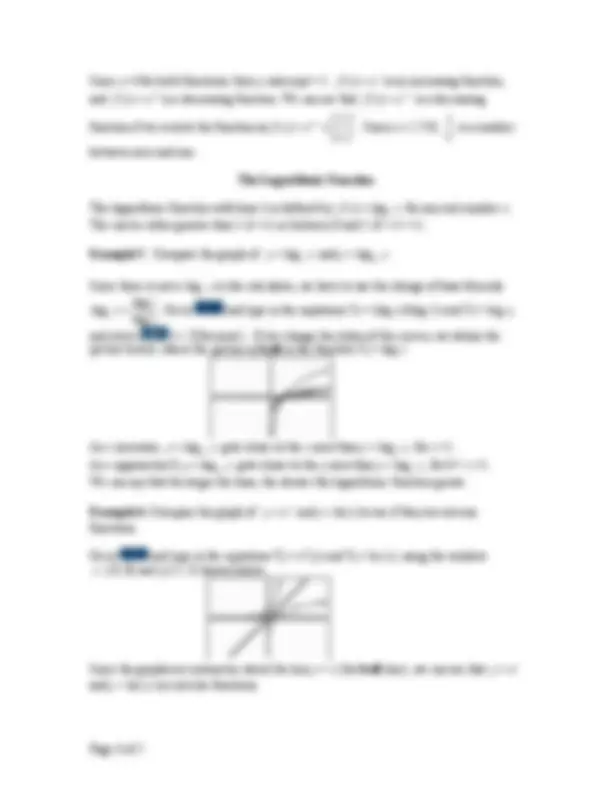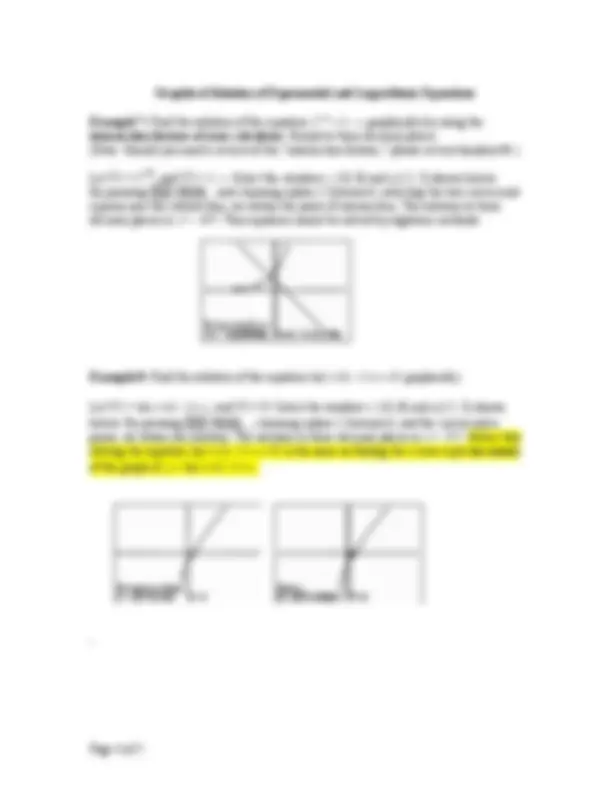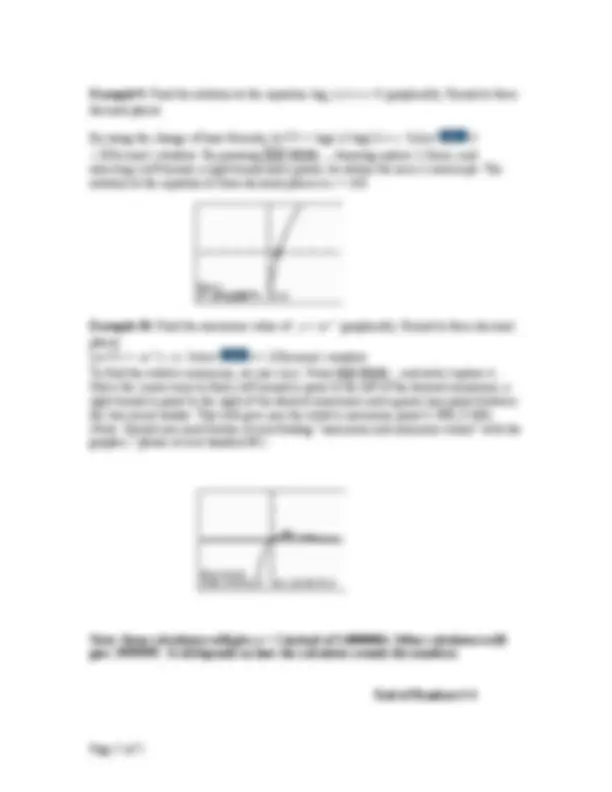





Study with the several resources on Docsity

Earn points by helping other students or get them with a premium plan


Prepare for your exams
Study with the several resources on Docsity

Earn points to download
Earn points by helping other students or get them with a premium plan
Community
Ask the community for help and clear up your study doubts
Discover the best universities in your country according to Docsity users
Free resources
Download our free guides on studying techniques, anxiety management strategies, and thesis advice from Docsity tutors
Material Type: Notes; Class: College Algebra LinC; Subject: MAC: Math - Calc/Pre-Calc; University: Valencia Community College; Term: Unknown 1989;
Typology: Study notes
1 / 5

This page cannot be seen from the preview
Don't miss anything!




In this handout, you will familiarize with the graphs of Exponential and Logarithmic functions.
The Exponential Function
The exponential function with base b is defined by f ( ) x = abx. Since f (0)= ab^0 = a , a is
the y -intercept of the function. If the base is greater than 1 ( b >1), the function increases (exponential growth). If the base is between 0 and 1 (0< b <1), the function decreases
(exponential decay). The domain of the exponential function f ( ) x = abx is all the real
Example 1: Compare the graphs of f ( ) x = 2 x and f ( ) x = 10 x
Go to and type in the equations Y 1 (^) = 2 ^ x and Y 2 (^) = 10 ^ x, and select 4
( ZDecimal ). If we change the styles of the curves, we obtain the graph picture, where the graph in bold is the function Y 2 (^) = 10 ^ x.
Notice that both functions are of the form f ( ) x = abx since Y 1 (^) = 2 ^ x with a =1 and b = 2,
and Y 2 (^) = 10 ^ x with a =1 and b =10.
If we compare the two graphs, we see that the functions are increasing since the base b > for both of them. Since a =1 for both functions, their y -intercept = 1.
f ( ) x = 10 x grows faster than f ( ) x = 2 x as the positive values of x increase, and f ( ) x = 10 x decays faster than f ( ) x = 2 x as the negative values of x decrease. We can say
that the larger the base b , the faster the function grows.
Example 2: Compare the graphs of f ( ) x = 2 3⋅ x and f ( ) x = 2 x
Go to and type in the equations Y 1 (^) = 2*3 ^ x and Y 2 (^) = 2 ^ x and select 4
( ZDecimal). If we change the styles of the curves, we obtain the picture below, where the graph in bold is the function Y 2 (^) = 2 ^ x.
Since a = 2 for Y 1 , and a =1 for Y 2 , the y -intercept of Y 1 is 2 while the y -intercept of Y 2 (the bold curve) is 1.
Example 3: Compare the graphs of f ( ) x = 2 x and f ( ) x = ex
Go to and type in the equations Y 1 = 2^( x ) and Y 2 = e^( x ) , and select 4 ( ZDecimal ). e ^( x ) can be obtained by pressing ` and the L keys. If we change the styles of the curves, we obtain the picture below, where the graph in bold is the function Y 2 = ex.
If we compare the two graphs we see that both graphs cross the y -axis at y = 1. Since e ≈ 2.718is larger than 2, we see that f ( ) x = ex grows faster than f ( ) x = 2 x. All
the exponential functions with base b >1 will have the same shape. The difference will be that the higher the value of the base, the faster the function will increase.
Example 4: Compare the graphs of f ( ) x = ex and f ( ) x = e − x
Go to and type in the equations Y 1 = e^( x ) and Y 2 = e^(- x ) , and select 4 ( ZDecimal ). e ^( x ) can be obtained by pressing ` and the L keys. To enter e^(- x ) , choose the _ key (to the left of e). If we change the styles of the curves, we obtain
the picture below, where the graph in bold is the function Y 2 = e − x.
Graphical Solution of Exponential and Logarithmic Equations
Example 7: Find the solution of the equation 2 x^ +^1 = 1 − x graphically by using the intersection feature of your calculator. Round to three decimal places. (Note: Should you need a review of the “intersection feature,” please review handout #1.)
Let Y1 = 2 x +1^ , and Y2 = 1- x. Select the window x : [-8, 8] and y:[-5, 5] shown below.
a guess near the intersection, we obtain the point of intersection. The solution to three decimal places is x = -.457. This equation cannot be solved by algebraic methods.
Example 8: Find the solution of the equation ln( x + 1) − 1 + x = 0 graphically.
Let Y1 = ln( x + 1) − 1 + x , and Y2 = 0. Select the window x : [-8, 8] and y:[-5, 5] shown
guess, we obtain the solution. The solution to three decimal places is x = .557. Notice that solving the equation ln( x + 1) − 1 + x = 0 is the same as finding the x-intercepts (or zeros)
of the graph of y = ln( x + 1) − 1 + x.
Example 9: Find the solution to the equation log ( ) 2 x + x = 0 graphically. Round to three
decimal places
By using the change of base formula, let Y1 = log( ) / log(2) x + x. Select 4
selecting a left bound, a right bound and a guess, we obtain the zero ( x -intercept). The solution to the equation to three decimal places is x =.
Example 10: Find the maximum value of y = xe − x graphically. Round to three decimal
places Let Y1 = xe ^ ( − x ). Select 4 ( ZDecimal ) window
To find the relative maximum, we use CALC. Press ` $, , and select option 4. Move the cursor keys to find a left bound (a point to the left of the desired minimum), a right bound (a point to the right of the desired minimum) and a guess (any point between the two arrow heads). That will give you the relative maximum point (1.000, 0.368). (Note: Should you need further review finding “maximum and minimum values” with the grapher,” please review handout #3.)
Note: Some calculators will give x = 1 instead of 1.0000004. Other calculators will give .9999999. It all depends on how the calculator rounds the numbers.
End of Handout # 4